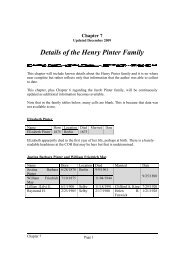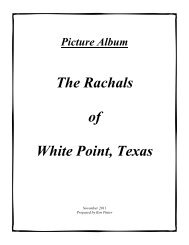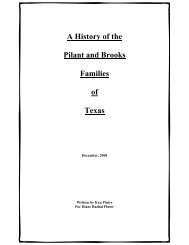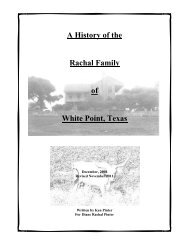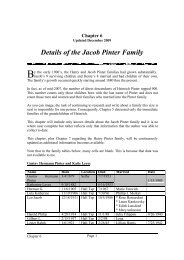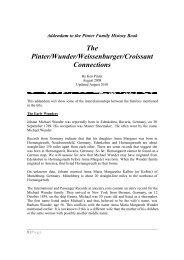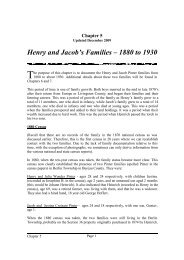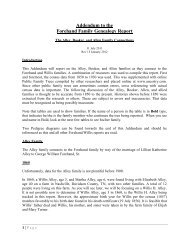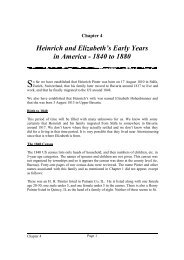Early Farm Life in Bureau County, Illinois, and ... - New Page 1
Early Farm Life in Bureau County, Illinois, and ... - New Page 1
Early Farm Life in Bureau County, Illinois, and ... - New Page 1
Create successful ePaper yourself
Turn your PDF publications into a flip-book with our unique Google optimized e-Paper software.
Chapter 8<br />
<strong>Early</strong> <strong>Farm</strong> <strong>Life</strong> <strong>in</strong> <strong>Bureau</strong> <strong>County</strong>,<br />
Ill<strong>in</strong>ois, <strong>and</strong> Conclusion<br />
T<br />
he reader should be aware that the content of this chapter is based partially on family<br />
facts <strong>and</strong> partially on other written accounts of the era. The author has taken the<br />
liberty to embellish the known family facts with detail derived from other reference<br />
sources <strong>in</strong>clud<strong>in</strong>g but not limited to Web resources.<br />
When embellish<strong>in</strong>g the facts, the author was careful to <strong>in</strong>clude only material that is<br />
generally known about the life <strong>and</strong> times <strong>in</strong> the 1800’s such that this chapter should be an<br />
<strong>in</strong>tegration of family details plus general detail that fit together so as to present a<br />
reasonably accurate view of life <strong>in</strong> that time.<br />
This chapter also conta<strong>in</strong>s some review from pervious chapters.<br />
Introduction<br />
In all probability, He<strong>in</strong>rich <strong>and</strong> Elizabeth traveled to the United States from Germany around<br />
1848-1850. How they got here, what they looked like, what they did after arrival, <strong>and</strong> what<br />
their life was like is any one’s guess.<br />
All we have to go on are the writ<strong>in</strong>gs <strong>and</strong> recollections of others, family <strong>and</strong> non-family,<br />
who are long s<strong>in</strong>ce gone but who <strong>in</strong> some way recorded various accounts of life <strong>in</strong> that time.<br />
And, we are lucky to have a rather large collection of family photographs. One th<strong>in</strong>g <strong>in</strong> our<br />
favor is that the P<strong>in</strong>ter family tended to take a lot of pictures after about 1878.<br />
So, this chapter is an attempt to put together a story of <strong>Farm</strong> <strong>Life</strong> <strong>in</strong> <strong>Bureau</strong> <strong>County</strong>,<br />
specifically the farm lives of the Jacob <strong>and</strong> Henry P<strong>in</strong>ter Family, with accounts back to about<br />
1848. The chances are pretty good that much of what is written here is accurate enough that<br />
we can ga<strong>in</strong> a little <strong>in</strong>sight <strong>in</strong>to the realities of life <strong>in</strong> that time.<br />
Chapter 8 <strong>Page</strong> 1
Passage to <strong>Bureau</strong> <strong>County</strong> <strong>and</strong> the early years of He<strong>in</strong>rich <strong>and</strong> Family<br />
We will probably never know the exact circumstances surround<strong>in</strong>g He<strong>in</strong>rich <strong>and</strong> Elizabeth’s<br />
arrival <strong>in</strong> the US. We might never know why they left Germany except to say that there was a<br />
migration to the US from Germany <strong>and</strong> other European countries prompted by poverty,<br />
religious convictions, <strong>and</strong> the urge to go west to the US.<br />
1820-1871 - Economic hardships, <strong>in</strong>clud<strong>in</strong>g those<br />
caused by unemployment, crop failure <strong>and</strong> starvation,<br />
was the primary cause of emigration dur<strong>in</strong>g this period,<br />
<strong>in</strong> comb<strong>in</strong>ation with wars <strong>and</strong> military service. Most of<br />
the emigrants came from Alsace-Lorra<strong>in</strong>e, Baden,<br />
Hessen, Rhe<strong>in</strong>l<strong>and</strong>, <strong>and</strong> Württemberg.<br />
Source: http://www.roll<strong>in</strong>tl.com/roll/gr1900us.htm<br />
The follow<strong>in</strong>g article was taken from an article titled Ill<strong>in</strong>ois, the Prairie State, by the Lee<br />
<strong>County</strong> Historical Society, which was found on the Web site<br />
http://www.leecountyhistory.com/articles/931118.htm.<br />
Lee <strong>County</strong> shares a border with <strong>Bureau</strong> <strong>County</strong>.<br />
Together, the railroad, the new plow <strong>and</strong> the reaper made it<br />
possible to settle <strong>and</strong> farm the Midwest. Now the people<br />
came to the prairies, not by wagon tra<strong>in</strong> or oxcart, but by<br />
barge, steamboat <strong>and</strong> tra<strong>in</strong>. They came not by the hundreds<br />
but by the thous<strong>and</strong>s. In the half century between 1840 <strong>and</strong><br />
1890 the population of Ill<strong>in</strong>ois went from 476,000 to nearly<br />
4 million. And it was the great European migrations of the<br />
n<strong>in</strong>eteenth century that so <strong>in</strong>creased the population so<br />
rapidly. On the heels of the English <strong>and</strong> Scots came the<br />
Irish. Then followed by Norwegians, Germans, Poles,<br />
Czechs, Russians, Italians, French, Dutch, <strong>and</strong> Belgians.<br />
To many the state offered liv<strong>in</strong>g space for homes, farms<br />
<strong>and</strong> crops such as they had never dreamed of. These<br />
immigrants came first as homesteaders or as they came to<br />
be called, "sodbusters." And it was their thought to make<br />
Ill<strong>in</strong>ois prairies one of the most productive farm<strong>in</strong>g regions<br />
<strong>in</strong> the country. As Chicago grew <strong>in</strong>to a city, its labor force<br />
grew <strong>in</strong> its stockyards, railroad yards, mills <strong>and</strong> factories.<br />
Great numbers were migrat<strong>in</strong>g from the south <strong>in</strong>to the state.<br />
In the 1850's Chicago <strong>and</strong> Ill<strong>in</strong>ois became the heart of a<br />
giant new <strong>in</strong>dustry. Iron ore was shipped down from the<br />
Great Lakes from northern M<strong>in</strong>nesota, while up from<br />
southern Ill<strong>in</strong>ois, which had been found to have the richest<br />
bitum<strong>in</strong>ous coal deposits <strong>in</strong> the nation, soon came mile long<br />
Chapter 8 <strong>Page</strong> 2
freight tra<strong>in</strong>s of fuel for the blast furnaces <strong>and</strong> foundries.<br />
Ill<strong>in</strong>ois, the twenty first state hav<strong>in</strong>g atta<strong>in</strong>ed statehood on<br />
December 3, 1818 would soon become an <strong>in</strong>dustrial giant<br />
along with be<strong>in</strong>g one of the nation's major producers of<br />
agricultural products.<br />
We know from the (Church on the Hill) COH death record of Elizabeth that she was born the<br />
village of either Aiterste<strong>in</strong>er<strong>in</strong>g or Forste<strong>in</strong>er<strong>in</strong>g <strong>in</strong> Bavaria, east of Munich <strong>in</strong> 1813. These<br />
villages still exist <strong>and</strong> are relatively close to each other.<br />
We also know that He<strong>in</strong>rich was born <strong>in</strong> Stäfa, Switzerl<strong>and</strong>. He moved later to Germany at<br />
about the age of 6 or 7.<br />
We may never learn the port of entry <strong>and</strong> exact time when they arrived <strong>in</strong> America. We may<br />
never know if they came together, or separately, married or not.<br />
It is documented <strong>in</strong> genealogy.com’s Passenger <strong>and</strong> Immigration Lists that a H. Bender<br />
arrived <strong>in</strong> <strong>New</strong> Orleans on January 2, 1850 on the ship the Ohio from Bremen, Germany. The<br />
records show he was 40 years old (Birth year 1810 which matches He<strong>in</strong>rich’s documented<br />
birth year). There are no other records that provide this good of a match for the names<br />
Bender, B<strong>in</strong>der, P<strong>in</strong>ter, Pa<strong>in</strong>ter, Punter, Puenter, etc.<br />
Rem<strong>in</strong>der to the reader: In the course of research<strong>in</strong>g this family, all of the above listed names<br />
have presented themselves as be<strong>in</strong>g credible names for this family. For a review, see Chapter<br />
1.<br />
It is also documented <strong>in</strong> this same list<strong>in</strong>g that an Elizabeth Hohenbrunner arrived at <strong>New</strong><br />
York <strong>in</strong> 1848 from Upper Bavaria. No age or ship name is given.<br />
There is also an Elizabeth Bender, age 37, who arrived <strong>in</strong> <strong>New</strong> Orleans from Antwerp,<br />
Belgium, on March 15, 1848 on the ship Desdemona.<br />
Note: it is written <strong>in</strong> a 1928 newspaper article describ<strong>in</strong>g<br />
Jacob <strong>and</strong> Just<strong>in</strong>a’s 50 th wedd<strong>in</strong>g anniversary that He<strong>in</strong>rich<br />
arrived <strong>in</strong> the US <strong>in</strong> 1848.<br />
Let’s assume that He<strong>in</strong>rich arrived <strong>in</strong> <strong>New</strong> Orleans <strong>in</strong> 1848. This is a good assumption<br />
because it is known that other <strong>Bureau</strong> <strong>County</strong> residents came <strong>in</strong>to the US this way. In<br />
addition, this was apparently the port of entry for the John Hasler family.<br />
He<strong>in</strong>rich may have had Ill<strong>in</strong>ois as his planned dest<strong>in</strong>ation before he left Germany. Many<br />
immigrants were <strong>in</strong> touch with friends who previously traveled to the US. Perhaps Elizabeth<br />
was already here. Perhaps they were travel<strong>in</strong>g together. Perhaps they were not yet married.<br />
Perhaps they married soon after he arrived <strong>in</strong> Ill<strong>in</strong>ois s<strong>in</strong>ce, per the 1850 census, Elisabeth<br />
<strong>and</strong> Henry Pa<strong>in</strong>ter were liv<strong>in</strong>g <strong>in</strong> <strong>Bureau</strong> <strong>County</strong> <strong>in</strong> 1850 when the census was taken.<br />
There is no evidence <strong>in</strong> the International <strong>and</strong> Passenger Records <strong>in</strong> Genealogy.com that any<br />
<strong>in</strong>dividual with the name Henry or He<strong>in</strong>rich or simply H., <strong>and</strong> with the surnames P<strong>in</strong>ter,<br />
Chapter 8 <strong>Page</strong> 3
Pa<strong>in</strong>ter, B<strong>in</strong>der, Punter, Puenter (or a whole host of other spell<strong>in</strong>gs), arrived by ship (with<br />
birth <strong>and</strong> other data that fits He<strong>in</strong>rich) when records were kept:<br />
He<strong>in</strong>rich <strong>and</strong> Elizabeth, either separately or together then most likely boarded a tra<strong>in</strong> or a ship<br />
(stern wheeler on the Mississippi) <strong>and</strong> traveled north to Ill<strong>in</strong>ois arriv<strong>in</strong>g <strong>in</strong> <strong>Bureau</strong> <strong>County</strong> by<br />
wagon or horse a few months later.<br />
He<strong>in</strong>rich <strong>and</strong> Elizabeth somehow ended up on the farm or <strong>in</strong> the home of John <strong>and</strong> Anna<br />
L<strong>and</strong>era (or L<strong>and</strong>ers) <strong>and</strong>, as the 1850 census shows, their name was recorded as Henry <strong>and</strong><br />
Elizabeth Pa<strong>in</strong>ter <strong>and</strong> it was implied or demonstrated to the census taker that they were<br />
married. It is also implied that the Pa<strong>in</strong>ters <strong>and</strong> the L<strong>and</strong>eras lived <strong>in</strong> the same dwell<strong>in</strong>g but it<br />
is not clear from the data who owned the dwell<strong>in</strong>g, where it was located, or if they might<br />
have simply been boarders.<br />
It is known that He<strong>in</strong>rich owned a 20 acre piece of l<strong>and</strong> near Trenton (later named DePue).<br />
Perhaps this is where they were liv<strong>in</strong>g. Or perhaps they were liv<strong>in</strong>g on the property just to the<br />
north of the COH cemetery because it is here that He<strong>in</strong>rich’s two sons were born. See<br />
Appendix C for locations of these properties.<br />
Note: the same article regard<strong>in</strong>g Jacob <strong>and</strong> Just<strong>in</strong>a’s wedd<strong>in</strong>g<br />
anniversary states that Jacob was born (<strong>in</strong> 1855) <strong>in</strong> a “log<br />
cab<strong>in</strong>”, the same cab<strong>in</strong> <strong>in</strong> which Just<strong>in</strong>a was born a few years<br />
later. This log cab<strong>in</strong> was situated north of the COH <strong>and</strong> on<br />
l<strong>and</strong> (farm) which was owned <strong>in</strong> 1929 by William Genzl<strong>in</strong>ger<br />
near Hollowayville. Who owned or lived on this l<strong>and</strong> <strong>in</strong> 1852<br />
thru 1855 is currently unknown. Was this He<strong>in</strong>rich’s farm or<br />
that of someone else such as a midwife or neighbor<br />
Nevertheless, about two plus years after arrival, Henry was born, <strong>in</strong> 1852. Jacob came along<br />
three years later, <strong>in</strong> 1855.<br />
In all probability, some time between when they lived with the L<strong>and</strong>eras <strong>and</strong> when Henry<br />
was born, they moved to the farm just north of the COH. This was probably rented<br />
farml<strong>and</strong> or else they may have been resident farmh<strong>and</strong>s. They would later purchase this<br />
80 acre piece of l<strong>and</strong>. For the next 15 years until 1865, He<strong>in</strong>rich <strong>and</strong> Elizabeth farmed <strong>in</strong><br />
<strong>Bureau</strong> <strong>County</strong>, either on their own farm or that of someone else.<br />
There is no evidence that He<strong>in</strong>rich was able to take advantage of the Homestead Act of 1862<br />
or the Ill<strong>in</strong>ois L<strong>and</strong> Grant programs of the time.<br />
Around 1814, Ill<strong>in</strong>ois, be<strong>in</strong>g a large unsettled territory, began<br />
to offer public l<strong>and</strong> for sale for the purposes of development.<br />
Between 1814 <strong>and</strong> 1850, little of this l<strong>and</strong> was purchased. A<br />
depression (1838-1847) plus the Blackhawk war (1832)<br />
<strong>in</strong>terfered to some extent. The real surge <strong>in</strong> purchases<br />
occurred between about 1851 <strong>and</strong> 1854 after construction of<br />
the Ill<strong>in</strong>ois <strong>and</strong> Michigan Canal was completed. F<strong>in</strong>ally, by<br />
1854, l<strong>and</strong> left over was granted to the Ill<strong>in</strong>ois Central<br />
Railroad Company.<br />
Chapter 8 <strong>Page</strong> 4
L<strong>and</strong> was sold <strong>in</strong> this time frame for $1.25 per acre. Over<br />
time, the m<strong>in</strong>imum l<strong>and</strong> purchase was reduced from 640 to 40<br />
acres <strong>and</strong> the price reduced from $2.00 to $1.25 per<br />
acre…therefore, by 1832, the smallest farm could be<br />
purchased for $50 (By that time, the average wage of a<br />
farmh<strong>and</strong> was $5 to $15 per month, so a farm was realizable<br />
for most farm h<strong>and</strong>s of the time).<br />
________________________________________________<br />
“The 1862 Homestead Act allowed any head of a family to<br />
stake a claim to a quarter section <strong>in</strong> the United States territory,<br />
farm it for five years, build a house, <strong>and</strong> thereafter obta<strong>in</strong><br />
legal title at no cost.”<br />
William C. Davis<br />
________________________________________________<br />
The Homestead Act of 1862 was, however, largely irrelevant<br />
to the state of Ill<strong>in</strong>ois <strong>and</strong> the Midwest s<strong>in</strong>ce most of the<br />
available l<strong>and</strong> had already been purchased. This Act mostly<br />
benefited the settlement of the Dakotas, M<strong>in</strong>nesota, Nebraska,<br />
<strong>and</strong> Kansas.<br />
(Note: There is clear evidence that William Croissant participated <strong>in</strong> the Ill<strong>in</strong>ois Public L<strong>and</strong><br />
Grant program. He purchased a total of nearly 160 acres on 1 September1847 <strong>and</strong> 27 April<br />
1848 for $1.25 per acre <strong>and</strong> this is documented <strong>in</strong> the Ill<strong>in</strong>ois Public L<strong>and</strong> Purchase records.<br />
This l<strong>and</strong> was <strong>in</strong> Westfield Tsp, <strong>Bureau</strong> <strong>County</strong>. William Croissant was the father of Just<strong>in</strong>a<br />
Croissant who married Jacob P<strong>in</strong>ter <strong>in</strong> 1878)<br />
There is also a record<strong>in</strong>g of a purchase of 40 acres by a Henry<br />
R. Pa<strong>in</strong>ter <strong>in</strong> Fulton <strong>County</strong> on 3 October 1849. And, there is<br />
a Henry H. Pa<strong>in</strong>ter <strong>in</strong> the Fulton <strong>County</strong> 1850 census (note:<br />
Henry H. was only 22 years old <strong>in</strong>1850, so this Henry H is not<br />
ours). Are these the same person, or two different Pa<strong>in</strong>ters If<br />
different, is one of them our He<strong>in</strong>rich Remember that Henry<br />
<strong>and</strong> Elizabeth Pa<strong>in</strong>ter are listed <strong>in</strong> the 1850 census <strong>in</strong> <strong>Bureau</strong><br />
<strong>County</strong>. If the Fulton Co. l<strong>and</strong> is theirs, then they apparently<br />
did not stay there very long before mov<strong>in</strong>g to <strong>Bureau</strong> <strong>County</strong>.<br />
Henry, Elizabeth <strong>and</strong> the boys built up this farm through a lot of hard work. That was the<br />
German way. They acquired a few horses <strong>and</strong> other livestock <strong>and</strong> basic farm implements<br />
such as horse - drawn plows, wagons, <strong>and</strong> other implements <strong>and</strong> managed to make a liv<strong>in</strong>g<br />
rais<strong>in</strong>g various crops of the area <strong>in</strong>clud<strong>in</strong>g possibly corn, wheat, potatoes, <strong>and</strong> soy beans. In<br />
this time frame, Ill<strong>in</strong>ois was a major producer of wheat, so it might be that this farm was a<br />
wheat - produc<strong>in</strong>g farm.<br />
Many of their possessions were purchased or acquired by trade with the other farmers <strong>in</strong> the<br />
area s<strong>in</strong>ce barter<strong>in</strong>g was a way of life then.<br />
The follow<strong>in</strong>g was extracted from http://www.lhf.org/cgi-b<strong>in</strong>/gygsite.pl2~0 <strong>in</strong> an article<br />
titled 1850 Pioneer <strong>Farm</strong>. It references Iowa, but the <strong>in</strong>formation most likely also applies to<br />
Ill<strong>in</strong>ois:<br />
Chapter 8 <strong>Page</strong> 5
The split rail fence, wheat field, root<strong>in</strong>g pigs <strong>and</strong> log house<br />
represent a four-year-old farm, established when Iowa<br />
became a state <strong>in</strong> 1846. The farm site is <strong>in</strong> transition<br />
between subsistence agriculture (produc<strong>in</strong>g enough for the<br />
family to survive) <strong>and</strong> becom<strong>in</strong>g a profit-mak<strong>in</strong>g farm.<br />
Most farms <strong>in</strong> 1850 averaged 160 acres <strong>in</strong> size, with<br />
farmers cultivat<strong>in</strong>g anywhere from 25 to 40 acres. Corn,<br />
wheat <strong>and</strong> potatoes were the three major crops <strong>in</strong> 1850.<br />
Most farmers used their corn crop to feed the pigs that were<br />
then sold for profit. Wheat <strong>and</strong> hogs were cash crops for<br />
farmers, <strong>and</strong> potatoes were a staple with nearly every meal<br />
<strong>and</strong> lasted throughout the w<strong>in</strong>ter.<br />
Until pioneer families earned enough money to purchase<br />
modern 1850 technology, they relied on older farm<strong>in</strong>g<br />
methods. For example, women prepared food over an open<br />
fire even though wood-burn<strong>in</strong>g cookstoves were available.<br />
The majority of people who settled <strong>in</strong> Iowa <strong>in</strong> the 1840s<br />
<strong>and</strong> 1850s came from the Eastern United States, <strong>and</strong> were<br />
eager to build a multi-room dwell<strong>in</strong>g like they had lived <strong>in</strong><br />
before com<strong>in</strong>g west. Log houses were temporary structures<br />
that the pioneers improved or replaced once the farm was<br />
established.<br />
Pioneer families relied on poultry for three major purposes:<br />
meat, eggs, <strong>and</strong> money. Most pioneers who raised pigs built<br />
a smokehouse to help preserve the pork. In 1850, barns<br />
were of less significance to the farm than <strong>in</strong> later years.<br />
Pioneers used barns to store tools <strong>and</strong> some crops, rather<br />
than to house animals. The big barns that are associated<br />
with modern farms were not built <strong>in</strong> Iowa until the 1870s.<br />
Note: The above article refers to the Des Mo<strong>in</strong>es area of<br />
Iowa.<br />
The follow<strong>in</strong>g was written by Richard Hofstadter <strong>and</strong> was found on the web site<br />
http://edweb.tusd.k12.az.us <strong>and</strong> describes the chang<strong>in</strong>g role of the Ill<strong>in</strong>ois farmer <strong>in</strong> the<br />
1800s:<br />
Between 1815 <strong>and</strong> 1860 the character of American agriculture<br />
was transformed. The <strong>in</strong>dependent yeoman, outside of<br />
exceptional or isolated areas, almost disappeared before the<br />
relentless advance of commercial agriculture. The rise of<br />
native <strong>in</strong>dustry created a home market for agriculture, while at<br />
the same time dem<strong>and</strong>s arose abroad, at first for American<br />
cotton <strong>and</strong> then for American foodstuffs. A network of<br />
turnpikes, canals, <strong>and</strong> railroads l<strong>in</strong>ked the planter <strong>and</strong> the<br />
advanc<strong>in</strong>g Western farmer to these new markets, while the<br />
Eastern farmer, spurred by Western competition, began to<br />
Chapter 8 <strong>Page</strong> 6
cultivate more thoroughly the nearby urban outlets for his<br />
products. As the farmer moved out onto the flat, rich prairies,<br />
he found possibilities for the use of mach<strong>in</strong>ery that did not<br />
exist <strong>in</strong> the forest. Before long he was cultivat<strong>in</strong>g the prairies<br />
with horse-drawn mechanical reapers, steel plows, wheat <strong>and</strong><br />
corn drills, <strong>and</strong> threshers. The cash crop converted the<br />
yeoman <strong>in</strong>to a small entrepreneur, <strong>and</strong> the development of<br />
horse-drawn mach<strong>in</strong>ery made obsolete the<br />
simple old agrarian symbol of the plow. <strong>Farm</strong>ers ceased to be<br />
free of what the early agrarian writers had called the<br />
"corruptions" of trade. They were, to be sure, still<br />
"<strong>in</strong>dependent," <strong>in</strong> the sense that they owned their l<strong>and</strong>. They<br />
were a hardwork<strong>in</strong>g lot <strong>in</strong> the old tradition. But no longer did<br />
they grow or manufacture what they needed: they<br />
concentrated on the cash crop <strong>and</strong> began to buy more of their<br />
supplies from the county store. To take full advantage of<br />
mechanization, they engrossed as much l<strong>and</strong> as they could. To<br />
mechanize fully, they borrowed cash. Where they could not<br />
buy or borrow they might rent: by the 1850's Ill<strong>in</strong>ois farmers<br />
who could not afford mach<strong>in</strong>es <strong>and</strong> large barns were hir<strong>in</strong>g<br />
it<strong>in</strong>erant jobbers with mach<strong>in</strong>es to do their thresh<strong>in</strong>g. The shift<br />
from self-sufficient to commercial farm<strong>in</strong>g varied <strong>in</strong> time<br />
throughout the West <strong>and</strong> cannot be dated with precision, but it<br />
was complete <strong>in</strong> Ohio by about 1830 <strong>and</strong> twenty years later <strong>in</strong><br />
Indiana, Ill<strong>in</strong>ois, <strong>and</strong> Michigan. All through the great<br />
Northwest, farmers whose ancestors might have lived <strong>in</strong><br />
isolation <strong>and</strong> self-sufficiency were surrounded by jobbers,<br />
banks, stores, middlemen, horses, <strong>and</strong> mach<strong>in</strong>ery; <strong>and</strong> <strong>in</strong> so<br />
far as this process was unf<strong>in</strong>ished <strong>in</strong> 1860, the dem<strong>and</strong>s of the<br />
Civil War brought it to completion. As the Prairie <strong>Farm</strong>er said<br />
<strong>in</strong> 1868: "The old rule that a farmer should produce all that he<br />
required, <strong>and</strong> that the surplus represented his ga<strong>in</strong>s, is part of<br />
the past. Agriculture like all other bus<strong>in</strong>ess, is better for its<br />
subdivisions, each one grow<strong>in</strong>g that which is best suited to his<br />
soil, skill, climate <strong>and</strong> market, <strong>and</strong> with its proceeds<br />
purchas<strong>in</strong>g his other needs."<br />
He<strong>in</strong>rich <strong>and</strong> his family were farm<strong>in</strong>g right <strong>in</strong> the middle to end of this transformation.<br />
Therefore we can assume that as his farm grew, he probably progressed to the po<strong>in</strong>t where he<br />
sold what he raised along with the other farmers <strong>in</strong> the area, <strong>and</strong> used the cash to purchase<br />
supplies, equipment, <strong>and</strong> additional l<strong>and</strong>. While this is just an assumption for He<strong>in</strong>rich, you<br />
can be sure that is how Jacob <strong>and</strong> Henry farmed between 1880 <strong>and</strong> 1920.<br />
It is hard to image He<strong>in</strong>rich’s home at this time. Was it a crude log cab<strong>in</strong> as noted earlier, or<br />
was it a frame structure with furniture, hardwood floors, etc Homebuild<strong>in</strong>g technology <strong>in</strong><br />
the 1860’s was such that farm <strong>and</strong> city dwell<strong>in</strong>gs were of this type. Just look at the L<strong>in</strong>coln<br />
home <strong>in</strong> Spr<strong>in</strong>gfield. But, He<strong>in</strong>rich <strong>and</strong> family were struggl<strong>in</strong>g to establish themselves <strong>in</strong> the<br />
prairie l<strong>and</strong>s of Ill<strong>in</strong>ois <strong>and</strong> so it is difficult to imag<strong>in</strong>e the appearance of their homestead <strong>in</strong><br />
the 1850/60 time frame. Remember that there were only four of them, <strong>and</strong> the sons were<br />
young.<br />
Chapter 8 <strong>Page</strong> 7
Log cab<strong>in</strong> homes of the mid 1850’s were not all that crude. Pictures obta<strong>in</strong>ed from the Web<br />
show them to be comfortable, possibly two stories (perhaps a loft) with glass w<strong>in</strong>dows <strong>and</strong><br />
framed doors. Logs form the walls, with various materials stuffed <strong>in</strong> the creases to seal out<br />
the cold. The follow<strong>in</strong>g are examples of cab<strong>in</strong>s of the era.<br />
No <strong>in</strong>formation on this home<br />
Built 1854 <strong>in</strong> Fairview<br />
Heights, IL<br />
<strong>Farm</strong><strong>in</strong>g the l<strong>and</strong> was tough for He<strong>in</strong>rich <strong>and</strong> his family. Each day was occupied by clear<strong>in</strong>g<br />
l<strong>and</strong>, plow<strong>in</strong>g <strong>and</strong> plant<strong>in</strong>g crops <strong>and</strong> then harvest<strong>in</strong>g them, all by the use of horse-drawn<br />
equipment. Even<strong>in</strong>gs were spent work<strong>in</strong>g on the cab<strong>in</strong> or house, barns, <strong>and</strong> other local tasks.<br />
But, they usually retired early s<strong>in</strong>ce there was much more work to be done the next day. In<br />
the fall <strong>and</strong> w<strong>in</strong>ter, much time was spent around the fireplace or sitt<strong>in</strong>g <strong>in</strong> a kerosene lanternlit<br />
room.<br />
He<strong>in</strong>rich <strong>and</strong> Elizabeth probably spoke only German <strong>and</strong> so Henry <strong>and</strong> Jacob learned<br />
German as children. It is presumed that they attended school early <strong>in</strong> their lives <strong>and</strong><br />
eventually learned to speak English. Perhaps this was done at the church or at small schools<br />
<strong>in</strong> the area.<br />
Elizabeth’s role on the farm was mostly to prepare meals <strong>and</strong> to tend to the household. She<br />
also cared for any livestock they might have owned. She also tended to a small garden where<br />
vegetables were grown for their personal consumption.<br />
Family transportation was accomplished via horse drawn wagons or buggies. Trips to church<br />
or to Ladd or Pr<strong>in</strong>ceton <strong>and</strong> other surround<strong>in</strong>g villages were done by wagon or by horseback.<br />
In 1864, the Courthouse records show that He<strong>in</strong>rich was f<strong>in</strong>ally able to purchase the 80 acre<br />
farm (north of the COH) from Nathanial <strong>and</strong> Henrietta Chauncey. This occurred on 13<br />
September 1864. Chauncey had previously acquired this l<strong>and</strong> from Elihu Chauncey who it is<br />
believed acquired this l<strong>and</strong> <strong>in</strong> one of the l<strong>and</strong> grant programs of earlier times. He<strong>in</strong>rich paid<br />
$800 for this l<strong>and</strong>.<br />
Chapter 8 <strong>Page</strong> 8
Th<strong>in</strong>gs were look<strong>in</strong>g up for the family. They had acquired l<strong>and</strong> of their own <strong>and</strong> were mak<strong>in</strong>g<br />
a go of farm<strong>in</strong>g. Their family was small with just two sons, but they had managed to build a<br />
house (possibly a log cab<strong>in</strong> as noted above), <strong>and</strong> a barn, <strong>and</strong> had acquired livestock <strong>and</strong> horse<br />
drawn implements to farm the l<strong>and</strong>.<br />
Tragedy Strikes<br />
Then, <strong>in</strong> 1865, the family was hit with its first tragedy when Elizabeth died. She was only<br />
about 52 years old <strong>and</strong> her children were 10 (Jacob) <strong>and</strong> 14 (Henry) years old. It is not<br />
known if she perhaps died <strong>in</strong> child birth (unlikely) or was <strong>in</strong>jured <strong>in</strong> a farm<strong>in</strong>g accident, or<br />
contracted a disease. It is likely that she contracted a disease s<strong>in</strong>ce this was common at the<br />
time, <strong>and</strong> medic<strong>in</strong>es (<strong>and</strong> doctors) were not very advanced. In fact, the COH records <strong>in</strong>dicate<br />
she died of a fever. The cause of death is written <strong>in</strong> German <strong>and</strong> the h<strong>and</strong>writ<strong>in</strong>g is poor <strong>and</strong><br />
only the word “fieber” (fever) can be determ<strong>in</strong>ed<br />
He<strong>in</strong>rich <strong>and</strong> the boys were now feel<strong>in</strong>g the pa<strong>in</strong> of the loss of Elizabeth. In order to lessen<br />
that pa<strong>in</strong>, they decided to leave <strong>Bureau</strong> <strong>County</strong>. They sold both pieces of l<strong>and</strong> to George<br />
Halte for $3000 on 14 August 1865, three months after Elizabeth died. Then <strong>in</strong> early 1866,<br />
He<strong>in</strong>rich auctioned off all his farm<strong>in</strong>g equipment <strong>and</strong> livestock.<br />
In 1966, He<strong>in</strong>rich also applied for <strong>and</strong> received a passport, presumably with the <strong>in</strong>tent that he<br />
<strong>and</strong> the boys would leave the US. Note that some accounts say that the three went to<br />
Liv<strong>in</strong>gston <strong>County</strong> to farm but 1870 census data does not support this. Neither does the act of<br />
sell<strong>in</strong>g all of his worldly possessions.<br />
Return to <strong>Bureau</strong> <strong>County</strong><br />
For whatever reason, He<strong>in</strong>rich’s plans changed. He<strong>in</strong>rich, Jacob, <strong>and</strong> Henry came back to the<br />
US sometime later. The time frame is not precisely known except to say that He<strong>in</strong>rich<br />
reappeared <strong>in</strong> <strong>Bureau</strong> <strong>County</strong> on or before 15 October 1874 <strong>and</strong> purchased 80 acres of farm<br />
l<strong>and</strong> from Lawrence Schr<strong>in</strong>er <strong>and</strong> his wife for $4400. This is E2 NE Section 36 Berl<strong>in</strong><br />
Township. See Appendix C. The Warrantee Deed <strong>in</strong>dicates that He<strong>in</strong>rich was a resident of<br />
Liv<strong>in</strong>gston <strong>County</strong>.<br />
This purchase date is 10 months after the marriage of Henry to Juliana Wunder on a very<br />
cold 4 th of January, 1874. Henry was 21 years old. Juliana was 19 ½ years old. Jacob was<br />
about 19 years old.<br />
Courthouse records show that He<strong>in</strong>rich (listed as a widower on the deed) apparently sold or<br />
gave an <strong>in</strong>terest <strong>in</strong> this l<strong>and</strong> to his son Henry on 12 August 1882.They also deeded ROW<br />
rights to the railroad <strong>in</strong> 1887 for $520. In 1888, they also sold coal rights to Whitebreast Fuel<br />
Company on 21 July 1888 for $1200. This parcel of l<strong>and</strong> was f<strong>in</strong>ally sold out of the family to<br />
R.L Hassler <strong>in</strong> 1941 for $19500.<br />
Consider<strong>in</strong>g the sequence of events above, one has to wonder how <strong>and</strong> when Henry courted<br />
Juliana. In 1850 <strong>and</strong> 1860 (per the census) the Adam Wunder family is not listed nationally.<br />
In 1870 (per the census) Juliana was 14 years old <strong>and</strong> liv<strong>in</strong>g at home with her parents Adam<br />
<strong>and</strong> Elizabeth Wunder <strong>and</strong> 10 brothers <strong>and</strong> sisters <strong>in</strong> <strong>Bureau</strong> <strong>County</strong>, Westfield Township.<br />
There were no Wunders <strong>in</strong> Liv<strong>in</strong>gston <strong>County</strong> <strong>in</strong> 1870. Where was Henry <strong>in</strong> 1870 Did he<br />
Chapter 8 <strong>Page</strong> 9
move back to <strong>Bureau</strong> <strong>County</strong> before 1874 Did they have a long distance romance which<br />
would have been a little difficult <strong>in</strong> that time frame<br />
Four more years would pass before Jacob married Just<strong>in</strong>a Croisant on 28 October 1878.<br />
Just<strong>in</strong>a was three months shy of her 17 th birthday. Jacob was 24 years old<br />
Henry <strong>and</strong> Juliana then apparently moved back to Liv<strong>in</strong>gston <strong>County</strong> shortly after their<br />
marriage <strong>and</strong> farmed there for some years, perhaps at the farm that they lived <strong>in</strong> earlier. In the<br />
mean time, Jacob probably rema<strong>in</strong>ed with his father <strong>in</strong> Section 36 Berl<strong>in</strong> Township <strong>and</strong><br />
worked there until he married Just<strong>in</strong>a <strong>in</strong> 1878.<br />
Follow<strong>in</strong>g 1878, there was a convergence back to a complete family aga<strong>in</strong> <strong>and</strong> the account<strong>in</strong>g<br />
of the family becomes a little more clear.<br />
Jacob <strong>and</strong> Henry Start Families, Build Wealth<br />
By 1880, Henry <strong>and</strong> Jacob were both married <strong>and</strong> had children. They were most likely liv<strong>in</strong>g<br />
on the property <strong>in</strong> Berl<strong>in</strong> Township purchased by their father He<strong>in</strong>rich <strong>in</strong> 1874 <strong>in</strong> the<br />
southeast corner of the township.<br />
By this time <strong>in</strong> 1880, the widowed He<strong>in</strong>rich was no longer farm<strong>in</strong>g on his own. He had<br />
retired <strong>and</strong> was listed <strong>in</strong> the census as liv<strong>in</strong>g with Henry <strong>and</strong> his family.<br />
This po<strong>in</strong>t marks the time when Jacob <strong>and</strong> Henry began their own families <strong>and</strong> began their<br />
own farm<strong>in</strong>g lifestyles. It also marks the po<strong>in</strong>t where their family <strong>and</strong> farm expansion began.<br />
Over the next 20 + years, Henry <strong>and</strong> Jacob worked their respective farms <strong>and</strong> added to their<br />
hold<strong>in</strong>gs. Appendix A has a more detailed timel<strong>in</strong>e of their farm expansion. Dur<strong>in</strong>g this time,<br />
He<strong>in</strong>rich made his home alternately with his two sons.<br />
Chapter 8 <strong>Page</strong> 10
(Note: We are at a loss to determ<strong>in</strong>e <strong>in</strong>formation about the family <strong>in</strong> 1890 s<strong>in</strong>ce most of the<br />
census data for that year was destroyed <strong>in</strong> a fire).<br />
As you read this account of the family, you beg<strong>in</strong> to see that the brothers Henry <strong>and</strong> Jacob<br />
seemed to follow the same path <strong>in</strong> life, both <strong>in</strong> occupations <strong>and</strong> <strong>in</strong> residences.<br />
Family Size<br />
He<strong>in</strong>rich <strong>and</strong> Elisabeth had only two boys (as far as we know). This is unusual, consider<strong>in</strong>g<br />
that families were typically large <strong>in</strong> this time. There is no evidence that they had more<br />
children. Elizabeth lived 10 more years after Jacob was born. Perhaps she could no longer<br />
have children, perhaps she was ill dur<strong>in</strong>g this time frame. Or perhaps, it was by choice.<br />
Jacob <strong>and</strong> Just<strong>in</strong>a had 12 children (5 boys <strong>and</strong> 7 girls) <strong>in</strong> the time frame of 1879 through<br />
1903, a span of 24 years. One daughter (no name) died at birth, one daughter (Carol<strong>in</strong>e) died<br />
at age 20 <strong>in</strong> childbirth, <strong>and</strong> one son (Louie) died from complications due to diabetes at age<br />
17.<br />
Henry <strong>and</strong> Juliana had 9 children (4 boys <strong>and</strong> 5 girls) <strong>in</strong> the time frame of 1875 to 1896. One,<br />
Elizabeth, died <strong>in</strong> <strong>in</strong>fancy.<br />
Joseph <strong>and</strong> Anna Leyes had 7 children (one boy, 6 girls). Only 4 children survived to live to<br />
an old age. One was Katie who married Gus P<strong>in</strong>ter.<br />
Wilhelm <strong>and</strong> Anna Croissant had 8 children (4 boys, 4 girls). All survived to older age. One<br />
daughter, Just<strong>in</strong>a, married Jacob.<br />
Adam <strong>and</strong> Elizabeth Wunder had at least 11 children, 7 boys <strong>and</strong> 4 girls. One daughter,<br />
Juliana, married Henry.<br />
Dwell<strong>in</strong>gs <strong>and</strong> Barns<br />
Quote by Eric Sloane<br />
“Many of the old barns were ventilated by pigeon holes, which were scattered decoratively<br />
about the upper reaches of the sidewalls. Although we now th<strong>in</strong>k of pigeons as be<strong>in</strong>g city<br />
birds, many of the early farmers preferred to keep pigeons rather than chickens. When he<br />
wanted a heavier bird for eat<strong>in</strong>g, he’d choose a duck or a wild turkey; but the children were<br />
given pigeon as a regular diet <strong>and</strong> pigeon pie was for the whole family”.<br />
Quote by Eric Sloane<br />
“The early farmer kept weather records <strong>in</strong> his diary. He regarded his weather almanac highly<br />
<strong>and</strong> watched the skies frequently because his every move was either helped or h<strong>in</strong>dered by<br />
weather. The weathervane on the barn was a more important <strong>in</strong>strument than a clock is on the<br />
farm today”.<br />
Quote by Eric Sloane<br />
“Most Midwest barns are faced with their sides fac<strong>in</strong>g the card<strong>in</strong>al po<strong>in</strong>ts while many <strong>New</strong><br />
Engl<strong>and</strong> <strong>and</strong> Southern barns had their corners, <strong>in</strong>stead, po<strong>in</strong>t<strong>in</strong>g to east, west, north <strong>and</strong><br />
south”.<br />
Chapter 8 <strong>Page</strong> 11
Quote by Eric Sloane<br />
“After the house <strong>and</strong> the big barn, there was always a smaller barn, a spr<strong>in</strong>ghouse, icehouse,<br />
milk house, wood shed <strong>and</strong> blacksmith shop. These, with the carriage shed <strong>and</strong> privy <strong>and</strong><br />
chicken houses, all made up a composition of geometric shapes that delighted the eye with its<br />
ability to blend with the contours of roll<strong>in</strong>g l<strong>and</strong>”.<br />
Quote by Isaac Weld, 1798<br />
”<strong>Farm</strong>ers are so certa<strong>in</strong> of their future that they spend a lifetime build<strong>in</strong>g barns for future<br />
generations”.<br />
Steam Eng<strong>in</strong>es, Thresh<strong>in</strong>g Mach<strong>in</strong>es, <strong>and</strong> other <strong>Farm</strong> Equipment<br />
Many years have passed s<strong>in</strong>ce Jacob <strong>and</strong> his brother Henry <strong>and</strong> their friends <strong>and</strong> neighbors<br />
<strong>and</strong> families farmed their fields <strong>in</strong> central Ill<strong>in</strong>ois. And th<strong>in</strong>k about Jacob <strong>and</strong> Henry as teens<br />
farm<strong>in</strong>g a small piece of l<strong>and</strong> <strong>in</strong> <strong>Bureau</strong> <strong>County</strong>. What did they grow <strong>and</strong> how did they<br />
harvest How did they earn <strong>in</strong>come What equipment did they own or use These questions<br />
may not be def<strong>in</strong>itively answered. We may be only able to speculate by <strong>in</strong>tegrat<strong>in</strong>g what little<br />
we know about them with the history of the times.<br />
Assum<strong>in</strong>g that He<strong>in</strong>rich <strong>and</strong> Elizabeth <strong>and</strong> Jacob <strong>and</strong> Henry farmed <strong>in</strong> the time frame of 1848<br />
<strong>and</strong> later, it must be assumed that if the farm had any size at all, they must have used horse<br />
drawn implements such as plows. The devices of the time required about two horses or oxen<br />
to pull them, <strong>and</strong> the farmer walked beh<strong>in</strong>d the plow assur<strong>in</strong>g it went <strong>in</strong> the right direction<br />
<strong>and</strong> actually cut <strong>in</strong>to the ground. The same can be said about other equipment used to harvest<br />
the gra<strong>in</strong>s they perhaps grew.<br />
Or, did they truck farm <strong>and</strong> simply grow eatable<br />
items that they perhaps sold to villagers such as<br />
those liv<strong>in</strong>g <strong>in</strong> Ladd <strong>and</strong> Pr<strong>in</strong>ceton <strong>and</strong> other<br />
surround<strong>in</strong>g towns.<br />
In any case, life was difficult. The entire day was<br />
spent do<strong>in</strong>g physical labor <strong>in</strong> the fields. Dur<strong>in</strong>g<br />
these early years, there was no steam powered<br />
equipment. Most work was done manually or with<br />
the assistance of horses.<br />
In the early 1800s, developments occurred <strong>in</strong><br />
mak<strong>in</strong>g steam power. By 1849, steam eng<strong>in</strong>es were be<strong>in</strong>g built that could power certa<strong>in</strong> k<strong>in</strong>ds<br />
of farm implements such as threshers which heretofore had to be powered by horses. But<br />
these eng<strong>in</strong>es were not tractors…. they were simply eng<strong>in</strong>es that had to be pulled to the work<br />
site by horses. And, they were big <strong>and</strong> expensive. At the time, a 4 horsepower eng<strong>in</strong>e cost<br />
$635 <strong>and</strong> weighed about two tons <strong>and</strong> produced a small steam pressure of about 50 psi.<br />
Thus, it hampered the amount of work that the eng<strong>in</strong>e could perform.<br />
By 1855 steam eng<strong>in</strong>e manufactures had converted the basic eng<strong>in</strong>e to a self propelled<br />
model, but the mach<strong>in</strong>e had to be steered by horses pull<strong>in</strong>g the eng<strong>in</strong>e to the right or left or<br />
straight ahead as it moved under its own power.<br />
By 1858, these self propelled rigs had been adapted to plow<strong>in</strong>g as well as to thresh<strong>in</strong>g.<br />
Chapter 8 <strong>Page</strong> 12
Steam eng<strong>in</strong>e development stalled dur<strong>in</strong>g<br />
the civil war, <strong>and</strong> then accelerated after the<br />
war. By 1880, the steam traction eng<strong>in</strong>e was<br />
available with a clutch, a steer<strong>in</strong>g<br />
mechanism, <strong>and</strong> generated over 150 psi of<br />
steam pressure.<br />
This steam traction eng<strong>in</strong>e is the k<strong>in</strong>d of<br />
mach<strong>in</strong>e we now associate with central<br />
Ill<strong>in</strong>ois farm<strong>in</strong>g. It was a smoky noisy<br />
behemoth that consumed large quantities of<br />
water <strong>and</strong> fuel (wood or coal) which had to<br />
be transported to the field or work site by<br />
horse.<br />
Based on a picture <strong>in</strong> the P<strong>in</strong>ter collection, we may assume that Henry or Jacob either owned<br />
a steam eng<strong>in</strong>e <strong>and</strong> thresh<strong>in</strong>g mach<strong>in</strong>e, or they participated <strong>in</strong> a Thresh<strong>in</strong>g R<strong>in</strong>g. A R<strong>in</strong>g was<br />
a group of farmers who shared a steam eng<strong>in</strong>e <strong>and</strong> thresh<strong>in</strong>g mach<strong>in</strong>e. They would transport<br />
this mach<strong>in</strong>e from farm to farm. A Thresh<strong>in</strong>g team of people was usually comprised of about<br />
19 people, so it is clear that thresh<strong>in</strong>g was a job that was shared by many farmers.<br />
Picture this <strong>in</strong> your m<strong>in</strong>ds eye……<br />
It is thresh<strong>in</strong>g day on the Jacob P<strong>in</strong>ter farm. It is 6 AM <strong>and</strong> the farm <strong>in</strong> stirr<strong>in</strong>g with activity.<br />
Just<strong>in</strong>a <strong>and</strong> Julianna <strong>and</strong> the girls are bak<strong>in</strong>g pies <strong>and</strong> prepar<strong>in</strong>g hearty meals for the thresh<strong>in</strong>g<br />
crew. Jacob <strong>and</strong> Henry <strong>and</strong> the boys are up <strong>and</strong> tend<strong>in</strong>g to the horses which will be used<br />
dur<strong>in</strong>g the day to br<strong>in</strong>g food to the field, transport water <strong>and</strong> fuel for the eng<strong>in</strong>e, <strong>and</strong> br<strong>in</strong>g<br />
wagonloads of gra<strong>in</strong> from the field to the thresh<strong>in</strong>g site to be threshed.<br />
(Thresh<strong>in</strong>g is the process of separat<strong>in</strong>g gra<strong>in</strong> from the hay or straw. The hay <strong>and</strong> straw is later<br />
fed to the farm animals while the gra<strong>in</strong> is sold for <strong>in</strong>come.)<br />
About 7 AM (or maybe the day before, who knows…), the steam traction eng<strong>in</strong>e <strong>and</strong><br />
thresh<strong>in</strong>g mach<strong>in</strong>e <strong>and</strong> crew of neighbor<strong>in</strong>g farmers come lumber<strong>in</strong>g onto the farm grounds<br />
<strong>and</strong> are moved directly to the thresh<strong>in</strong>g site. The eng<strong>in</strong>e <strong>and</strong> thresher are l<strong>in</strong>ed up <strong>and</strong> a long<br />
8 <strong>in</strong>ch belt is put <strong>in</strong> place <strong>in</strong> a figure 8 pattern between the eng<strong>in</strong>e’s fly wheel <strong>and</strong> the<br />
thresher. Meanwhile, some of the crew is out <strong>in</strong> the field load<strong>in</strong>g bails of gra<strong>in</strong> onto the<br />
wagon which will then be towed back to the thresher by a horse team. At this po<strong>in</strong>t, all hell<br />
breaks loose as the steam eng<strong>in</strong>e is revved up. Black, sooty smoke belches from the eng<strong>in</strong>e’s<br />
tall smoke stack. The thresher is put <strong>in</strong> gear <strong>and</strong> the dusty <strong>and</strong> dirty process of gra<strong>in</strong> thresh<strong>in</strong>g<br />
beg<strong>in</strong>s. A big cloud of dust looms over the area as the thresh<strong>in</strong>g process cont<strong>in</strong>ues as crew<br />
members throw pitch forks full of gra<strong>in</strong> <strong>in</strong>to the thresher’s <strong>in</strong>put hopper. Gra<strong>in</strong> drops out of<br />
the bottom of the thresher while the rema<strong>in</strong><strong>in</strong>g hay or straw is blown out of a tall stack <strong>in</strong>to<br />
what will become a mounta<strong>in</strong> of straw or hay next to the thresher.<br />
Chapter 8 <strong>Page</strong> 13
Idaho, 1909, from http://www.remmick.org/Remmick.Family.Tree/<strong>Page</strong>45.html#Opal<br />
Idaho, 1909<br />
Idaho, 1909<br />
Chapter 8 <strong>Page</strong> 14
Great pla<strong>in</strong>s, 1880-1920, from<br />
http://memory.loc.gov/ammem/award97/ndfahtml/ngp_farm_thresh<strong>in</strong>g.html<br />
N<strong>in</strong>e AM arrives…so do Just<strong>in</strong>a <strong>and</strong> Juliana <strong>and</strong> the women. They have a magnificent spread<br />
of breakfast foods <strong>and</strong> coffee. They spread this feast out on a canvas on the ground. It’s time<br />
for breakfast.<br />
This process goes on all day long. At noon, another feast is prepared. And, it happens aga<strong>in</strong><br />
at 3 PM.<br />
By 6 PM the job is over for the day. But, the process will be repeated aga<strong>in</strong> for additional<br />
days as required until the job is complete. Harvest is a difficult time for the farmers of<br />
<strong>Bureau</strong> <strong>County</strong>.<br />
Chapter 8 <strong>Page</strong> 15
From P<strong>in</strong>ter photo collection, year <strong>and</strong> location unknown<br />
Of course thresh<strong>in</strong>g is not the only implements used on the farm. Jacob <strong>and</strong> Henry no doubt<br />
own a couple of teams of horses, various wagons, plows <strong>and</strong> disk harrow units for l<strong>and</strong><br />
preparation <strong>and</strong> plant<strong>in</strong>g, <strong>and</strong> gra<strong>in</strong> b<strong>in</strong>ders to actually cut the gra<strong>in</strong> before thresh<strong>in</strong>g. The<br />
P<strong>in</strong>ter picture collection has a picture of Louie rid<strong>in</strong>g a horse drawn implement (plow)<br />
around 1910.<br />
.<br />
Louie P<strong>in</strong>ter on a plow circa 1910<br />
Crops <strong>and</strong> Animals<br />
Quote by William C. Davis<br />
“<strong>Farm</strong>er, plow, <strong>and</strong> ox teams worked from just before dawn until last twilight to break the<br />
sod, tear up the tangle of roots, <strong>and</strong> expose the untapped earth beneath. Almost to a man, they<br />
brought the seed for the crops they had known <strong>in</strong> the past, chiefly corn <strong>and</strong> wheat, with a<br />
scatter<strong>in</strong>g of several other gra<strong>in</strong>s depend<strong>in</strong>g on the soil <strong>and</strong> the farmer’s needs”.<br />
Chapter 8 <strong>Page</strong> 16
Quote by William C. Davis<br />
“Beside the sod-bust<strong>in</strong>g plow, the <strong>in</strong>vention of barbed wire was the other major factor that<br />
greatly hastened the clos<strong>in</strong>g of the open range. By 1873, wheat <strong>and</strong> alfalfa crops began to<br />
evidence greater profitability than ranch<strong>in</strong>g <strong>and</strong> these ranchers were astute enough to see that<br />
grow<strong>in</strong>g fruit <strong>and</strong> vegetables for the east, now that railroads made these markets more<br />
accessible, was even more lucrative”.<br />
Transportation<br />
Consider this: In the time frame that He<strong>in</strong>rich <strong>and</strong> Elizabeth were farm<strong>in</strong>g <strong>in</strong> <strong>Bureau</strong><br />
<strong>County</strong>, there was no such th<strong>in</strong>g as a steam powered vehicle. Steam power was never<br />
utilized to any great extent for personal transportation,<br />
<strong>and</strong> was adopted for use as farm equipment but not to<br />
any great extent until after the Civil War. And, gasol<strong>in</strong>e<br />
powered vehicles came alone much later. So, how did<br />
they get around back then. It is certa<strong>in</strong> that<br />
transportation was accomplished by horseback <strong>and</strong> by<br />
horse <strong>and</strong> buggy or wagon.<br />
So, try to visualize He<strong>in</strong>rich <strong>and</strong> Elizabeth <strong>and</strong> boys<br />
travel<strong>in</strong>g to church <strong>in</strong> a buggy or wagon pulled by one<br />
or two horses. Try to visualize this wagon sitt<strong>in</strong>g <strong>in</strong> the<br />
yard, the horses <strong>in</strong> the barn or barn yard. Try to<br />
visualize He<strong>in</strong>rich <strong>in</strong> his suit <strong>and</strong> Elizabeth <strong>in</strong> a long<br />
dress of the era rid<strong>in</strong>g down dirt <strong>and</strong> some times muddy<br />
<strong>and</strong> sometimes snow covered roads on their way to<br />
church or to visit friends or to visit town to get supplies.<br />
Note: the buggy advertisement to the right is dated<br />
1891.<br />
One only has to close their eyes <strong>and</strong> visualize this happen<strong>in</strong>g on a hot, dry day, or a ra<strong>in</strong>y<br />
summer day, or a cold snowy w<strong>in</strong>ter day to realize the hardships of life on the prairie <strong>in</strong><br />
this era.<br />
It is probable that, as Jacob <strong>and</strong> Henry came of age <strong>and</strong> began farm<strong>in</strong>g on their own<br />
around 1880, they had to utilize the same k<strong>in</strong>d of transportation. As you look at the<br />
various wedd<strong>in</strong>g pictures <strong>and</strong> other family portraits taken <strong>in</strong> the time frame of 1880 to<br />
1910, one has to wonder how they could get dressed up <strong>in</strong> suits <strong>and</strong> wedd<strong>in</strong>g or other<br />
dresses <strong>and</strong> travel to a church or to the photographer’s studio <strong>in</strong> horse drawn buggy or<br />
wagon. Consider do<strong>in</strong>g this on a cold day. Many wedd<strong>in</strong>gs <strong>in</strong> this family occurred <strong>in</strong> the<br />
w<strong>in</strong>ter.<br />
Chapter 8 <strong>Page</strong> 17
Here is a picture of a 1910 buggy.<br />
Buggies <strong>in</strong> earlier times probably<br />
looked similar to this as evidenced by<br />
L<strong>in</strong>coln’s buggy shown below.<br />
Photo from:<br />
http://www.r<strong>and</strong>olphlibrary.org/image.<br />
aspid='2867'.<br />
Photo of L<strong>in</strong>coln’s buggy, 1858, from:<br />
http://home.grics.net/~tbould/Museum.html<br />
Church<br />
The P<strong>in</strong>ter family was Luthern. This religion is prom<strong>in</strong>ent <strong>in</strong><br />
Germany <strong>and</strong> so it is natural that they practiced this religion <strong>in</strong> the<br />
US. The St. Johns Luthern Church on Route 6 just outside of<br />
Hollowayville on the way to Pr<strong>in</strong>ceton was their church. This<br />
church rema<strong>in</strong>s the P<strong>in</strong>ter church to this day. It has been referred to<br />
for some time as the Church on the Hill.<br />
The church photos shown at the right are the orig<strong>in</strong>al COH before<br />
<strong>and</strong> after the replacement of the steeple.<br />
Jacob <strong>and</strong> Henry were baptized, confirmed, <strong>and</strong> married by<br />
m<strong>in</strong>isters at this church. The church was formed <strong>in</strong> 1849. There are<br />
no records <strong>in</strong> the church that He<strong>in</strong>rich <strong>and</strong> Elizabeth were married<br />
here, however.<br />
In the late 1850s, a group of church members, dissatisfied with<br />
certa<strong>in</strong> practices of the church, broke away <strong>and</strong> formed a new<br />
church. Key members of this movement were William Croissant,<br />
Ludwig Merkel, Jacob Genzl<strong>in</strong>ger, Lorentz He<strong>in</strong>tz, <strong>and</strong> Herman<br />
Hassler. This church would be called the Deutsch Protestant<br />
Evangelical Church <strong>and</strong> was built between Seatonville <strong>and</strong><br />
Hollowayville. On 17 April 1858, Hassler donated the l<strong>and</strong> on which this church now lies to<br />
(apparently) a trust for the use by the church <strong>and</strong> its cemetery.<br />
Chapter 8 <strong>Page</strong> 18
Interest<strong>in</strong>gly, the P<strong>in</strong>ter families of He<strong>in</strong>rich, Jacob, <strong>and</strong> Henry rema<strong>in</strong>ed at the Luthern<br />
church through out this movement.<br />
When Jacob married Just<strong>in</strong>a <strong>in</strong> 1878, Jacob was a member of the COH while Just<strong>in</strong>a was a<br />
member of the Protestant Church of Hollowayville.<br />
Language <strong>and</strong> Education<br />
He<strong>in</strong>rich was born <strong>in</strong> Switzerl<strong>and</strong>. Elizabeth was born <strong>in</strong> Germany. Their native language<br />
was German. If they both arrived <strong>in</strong> the US <strong>in</strong> 1848, then they were about 34-38 years old<br />
at the time.<br />
When they f<strong>in</strong>ally arrived <strong>in</strong> <strong>Bureau</strong> <strong>County</strong>, they befriended fellow Germans <strong>in</strong> the area<br />
<strong>and</strong> then struggled for years try<strong>in</strong>g to make a liv<strong>in</strong>g farm<strong>in</strong>g their l<strong>and</strong>. He<strong>in</strong>rich lived 52<br />
more years <strong>in</strong> the US. Elizabeth lived only 17 years <strong>in</strong> the US years before her death. It is<br />
most likely that they never learned the English language except for a basic vocabulary.<br />
We do not know how much formal education Henry <strong>and</strong> Jacob had but it is likely that<br />
they attended some number of years of elementary school where they likely learned the<br />
language.<br />
W<strong>in</strong>ter<br />
It is difficult to image life <strong>in</strong> north central Ill<strong>in</strong>ois <strong>in</strong> the W<strong>in</strong>ter <strong>in</strong> the 1800’s <strong>and</strong> early<br />
1900’s. Those who have lived there know that snow fall can be substantial <strong>and</strong> that<br />
temperatures can fall to below zero levels dur<strong>in</strong>g a typical w<strong>in</strong>ter.<br />
Harold, son of Gus, son of Jacob frequently described w<strong>in</strong>ter nights where every one<br />
(kids, that is) slept <strong>in</strong> the same room to keep warm <strong>and</strong> that all they had to keep warm<br />
was a s<strong>in</strong>gle stove <strong>in</strong> the room where they slept. And, this was <strong>in</strong> the time frame of 1920-<br />
1940. Imag<strong>in</strong>e the years before that.<br />
Snow plows did not exist. Horse or mule-drawn buggies were the mode of transportation<br />
back then, <strong>and</strong> so it is perceived that movement around the area, for example to church,<br />
after a snowstorm either <strong>in</strong>volved no movement at all or else a rather difficult trek us<strong>in</strong>g<br />
horses/mules <strong>and</strong> buggies or wagons through potentially deep snow at perhaps very low<br />
temperatures.<br />
Women’s Role<br />
Quote by William C. Davis<br />
“Men <strong>and</strong> women performed reasonably well-def<strong>in</strong>ed roles on the frontier, though def<strong>in</strong>itions<br />
were often blurred by the simple necessity to get th<strong>in</strong>gs done regardless of whether or not it<br />
was "man’s" or "woman’s" work”.<br />
Chapter 8 <strong>Page</strong> 19
Cloth<strong>in</strong>g<br />
Quote by William C. Davis<br />
<strong>Farm</strong> or country women often wore coarse homemade garments or whatever was<br />
available: hardly glamorous.<br />
But, on the other h<strong>and</strong>, exam<strong>in</strong>e the apparel worn at wedd<strong>in</strong>gs. The women’s dresses were<br />
fancy, <strong>and</strong> apparently any flowers held by the brides were made of paper, especially <strong>in</strong><br />
w<strong>in</strong>ter. The grooms suits typically looked pressed <strong>and</strong> neat, with sh<strong>in</strong>y shoes/boots, but <strong>in</strong><br />
other pictures, the men’s shoes looked clearly worn.<br />
Plumb<strong>in</strong>g (<strong>and</strong> the Privy)<br />
Quote by Eric Sloane<br />
“Wallpapered <strong>and</strong> curta<strong>in</strong>ed, discreetly embowered at a considerable distance from the back<br />
of the house, was the privy. It was not regarded with the petty humor that surrounds it today,<br />
but was taken as seriously as the design of a bathroom is today. The familiar crescent shape<br />
cut <strong>in</strong>to these doors orig<strong>in</strong>ally designated the build<strong>in</strong>g as be<strong>in</strong>g one reserved for ladies, for the<br />
moon was always regarded as be<strong>in</strong>g female. The sun be<strong>in</strong>g regarded as male, it was once<br />
used as the design on the doors for gentlemen”.<br />
Wells <strong>and</strong> W<strong>in</strong>dmills<br />
Quote by William C.Davis<br />
“The steady breezes of the prairies made w<strong>in</strong>dmills ideal, <strong>and</strong> as the decades went on, more<br />
<strong>and</strong> more ref<strong>in</strong>ements were made <strong>in</strong> commercially manufactured mach<strong>in</strong>es so that tens of<br />
thous<strong>and</strong>s of them could be sent west, sold through mail order catalogs, for sums as little as<br />
$25. With noth<strong>in</strong>g more important than water, it was money well spent”.<br />
Unknown home<br />
Jacob P<strong>in</strong>ter <strong>and</strong> Family circa 1902 – see<br />
w<strong>in</strong>dmill beh<strong>in</strong>d the trees<br />
Chapter 8 <strong>Page</strong> 20
Jacob, as did most farmers, had a water well powered by a w<strong>in</strong>dmill. The 1901 picture of the<br />
Jacob P<strong>in</strong>ter homestead (above right) shows a w<strong>in</strong>dmill <strong>in</strong> the background beh<strong>in</strong>d the tree.<br />
This w<strong>in</strong>dmill was a Woodmanse unit made <strong>in</strong> Rockford, Ill<strong>in</strong>ois.<br />
The photo on the left shows a similar Woodmanse mill for the era. The note under that<br />
picture is as follows:<br />
Woodmanse Manufactur<strong>in</strong>g Company, Freeport, Ill<strong>in</strong>ois. Woodmanse Steel open backgeared<br />
steel pump<strong>in</strong>g w<strong>in</strong>dmill on steel tower beh<strong>in</strong>d a two-story wooden board<strong>in</strong>g house<br />
possibly <strong>in</strong> Clear Lake or Hampton, Iowa, ca. 1910; a h<strong>and</strong>written <strong>in</strong>scription notes, "his<br />
is Mama <strong>and</strong> Opal."<br />
Electricity<br />
Much of what we know about electricity today was formulated <strong>in</strong> the period after 1747. It<br />
started with Benjam<strong>in</strong> Frankl<strong>in</strong>’s experimentations <strong>in</strong>1747. Dur<strong>in</strong>g the 1800’s many strides<br />
were made <strong>in</strong> the areas of DC electricity <strong>and</strong> magnetism. The world saw the first DC motors<br />
as early as 1837. It wasn’t until abut 1887, however, that the country began to see electricity<br />
commercialized, by Thomas Edison. In1878, Edison founded the Edison Electric light<br />
Company, <strong>and</strong> <strong>in</strong> 1879, he designed the first <strong>in</strong>c<strong>and</strong>escent light bulb. From that po<strong>in</strong>t<br />
forward, advances <strong>in</strong> electricity happened at lighten<strong>in</strong>g speed for the urban areas of the US,<br />
but not <strong>in</strong> the rural areas.<br />
As the 1880’s <strong>and</strong> 90’s progressed, the US saw the development of localized power<br />
distribution systems. The technology of the day only allowed electrical power to be<br />
distributed <strong>in</strong> short distances, so rural areas were left out of the plan for power distribution.<br />
Thus, farmers <strong>in</strong> the time frame up until the 1930’s lived without the electrical energy<br />
sources available to their contemporaries <strong>in</strong> urban sett<strong>in</strong>gs.<br />
It is estimated that <strong>in</strong> the 1920’s, only 1% of the farmers <strong>in</strong> Ill<strong>in</strong>ois had electricity available to<br />
them. What makes this worse it that <strong>in</strong> many areas, electricity was available <strong>in</strong> the area but<br />
utility companies wanted to charge farmers nearly $3000 to connect them to this service.<br />
Many farmers <strong>in</strong> this time frame simply could not afford this expense so the did without.<br />
Dur<strong>in</strong>g the 1920’s, little progress was made. There was a mere 10 % improvement <strong>in</strong><br />
electrical distribution <strong>in</strong> rural Ill<strong>in</strong>ois.<br />
From web site http://www.lib.niu.edu/ipo/ic000110.html.<br />
It was this era of rural life <strong>in</strong> the United States that many older<br />
folks fondly remember. It was a time of family, of honesty, of<br />
God fear<strong>in</strong>g folk, when times were slower <strong>and</strong> more down-toearth<br />
than today. But when asked, these same people will<br />
recall the trials of life without electricity.<br />
Wayne Lan<strong>in</strong>g of Mt. Sterl<strong>in</strong>g, former director of Adams<br />
Electric Cooperative recalled, "The hot nights st<strong>and</strong> out most<br />
<strong>in</strong> my m<strong>in</strong>d. We'd put a mattress <strong>in</strong> the hayrack <strong>and</strong> go out<br />
<strong>in</strong>to the field where it was cool, but the bugs would come after<br />
Chapter 8 <strong>Page</strong> 21
us." Remember, there was no air condition<strong>in</strong>g or electric fans.<br />
People simply endured the hot <strong>and</strong>, conversely, cold weather.<br />
Lack of heat<strong>in</strong>g <strong>and</strong> cool<strong>in</strong>g weren't the only problems<br />
electricity would remedy. Another problem was dim light<strong>in</strong>g<br />
<strong>in</strong> the even<strong>in</strong>gs <strong>and</strong> early morn<strong>in</strong>g from kerosene lamps,<br />
result<strong>in</strong>g <strong>in</strong> poor read<strong>in</strong>g conditions <strong>and</strong> fire hazards.<br />
As the 1920s slipped away <strong>and</strong> the world was recover<strong>in</strong>g from<br />
the Great Depression of the 1930s, movement <strong>in</strong>creased<br />
rapidly towards rural electrification. Support grew for<br />
programs through President Frankl<strong>in</strong> Delano Roosevelt's <strong>New</strong><br />
Deal to provide electricity to rural Americans. Through the<br />
efforts of Morris Cooke, chairman of the Mississippi Valley<br />
Committee of the Public Works Adm<strong>in</strong>istration, $100 million<br />
was allocated towards rural electrification <strong>in</strong> 1935, giv<strong>in</strong>g<br />
birth to the Rural Electrification Adm<strong>in</strong>istration (REA).<br />
The state of Ill<strong>in</strong>ois followed <strong>in</strong> 1936 with the formation of<br />
the State Rural Electrification Committee. Although the<br />
committee didn't play an essential role <strong>in</strong> rural electrification,<br />
it did lend state support <strong>and</strong> organization to the projects.<br />
What this means to the P<strong>in</strong>ter family is simply this: The chances are pretty slim that Jacob<br />
<strong>and</strong> Henry had electricity on their farm, ever. They both retired sometime <strong>in</strong> the mid to late<br />
1920’s <strong>and</strong> moved to Ladd where electricity was presumably available.<br />
Henry <strong>and</strong> Jacob’s children lived on farms <strong>in</strong> this period <strong>and</strong> it is probable that they had no<br />
electricity until the mid 1930’s.<br />
So how did these families operate <strong>in</strong> the days before rural electrification Probably this way:<br />
<br />
<br />
<br />
<br />
<br />
<br />
<br />
Water was pumped from the well via a w<strong>in</strong>dmill.<br />
Cloths were ironed, if at all, with irons placed on a hot wood stove for a period of<br />
time.<br />
Heat <strong>in</strong> the home <strong>in</strong> the w<strong>in</strong>ter time was derived from stoves of some sort, possibly <strong>in</strong><br />
each room but probably only downstairs <strong>in</strong> the kitchen or sitt<strong>in</strong>g room.<br />
Late nights were spent <strong>in</strong> the dim light of kerosene lamps.<br />
Fans did not exist, so they looked for relief from heat where ever possible, perhaps <strong>in</strong><br />
the barn, perhaps <strong>in</strong> the creek, or <strong>in</strong> the fields.<br />
Thresh<strong>in</strong>g mach<strong>in</strong>es, saws, <strong>and</strong> other farm mach<strong>in</strong>ery were all powered by the steam<br />
eng<strong>in</strong>e or by horses.<br />
Meals were prepared on a wood-burn<strong>in</strong>g stove <strong>in</strong> the kitchen. Water for dishwash<strong>in</strong>g<br />
<strong>and</strong> bath<strong>in</strong>g was boiled on this same stove.<br />
U.S. agriculture statistic:<br />
In 1940, 25 percent of Americans lived on farms; average annual farm <strong>in</strong>come was<br />
$1,000.00. Three out of every four farms were lit by kerosene lamps.<br />
Chapter 8 <strong>Page</strong> 22
Can-Do Attitude<br />
Readers of this book <strong>and</strong> anyone who possesses the name P<strong>in</strong>ter <strong>and</strong> who is descended<br />
from He<strong>in</strong>rich <strong>and</strong> Elizabeth P<strong>in</strong>ter or who are related <strong>in</strong> some way to <strong>in</strong>dividuals<br />
descended from this family are rem<strong>in</strong>ded not to forget their roots.<br />
Modern day P<strong>in</strong>ters are descended from a long l<strong>in</strong>e of hard work<strong>in</strong>g farmers who saw an<br />
opportunity to be successful <strong>in</strong> America <strong>and</strong> who took advantage of the situation.<br />
Obstacles did not stop them. They approached problems with a can-do attitude <strong>and</strong> they<br />
simply found solutions. Their dreams prevailed.<br />
Their lives were not easy, but they were productive <strong>and</strong> successful.<br />
When the go<strong>in</strong>g gets tough, we would be well to remember He<strong>in</strong>rich <strong>and</strong> Elizabeth <strong>and</strong><br />
their two children, Jacob <strong>and</strong> Henry, their wives Just<strong>in</strong>a <strong>and</strong> Juliana, their 17 children,<br />
<strong>and</strong> the 900+ offspr<strong>in</strong>g of these 17 hard work<strong>in</strong>g people <strong>and</strong> their spouses, <strong>and</strong> He<strong>in</strong>rich<br />
<strong>and</strong> Elizabeth’s countless Gr<strong>and</strong>children <strong>and</strong> Great-gr<strong>and</strong>children <strong>and</strong> Great-greatgr<strong>and</strong>children,<br />
<strong>and</strong> all those to come.<br />
We should not forget those children of Jacob <strong>and</strong> Henry who unfortunately died before<br />
their time <strong>and</strong> never got the chance to participate <strong>in</strong> the success of the family over the<br />
years.<br />
Jacob <strong>and</strong> Just<strong>in</strong>a<br />
Infant daughter<br />
Ludwig Adolph P<strong>in</strong>ter<br />
Carol<strong>in</strong>a Just<strong>in</strong>a P<strong>in</strong>ter Rett<br />
Henry <strong>and</strong> Juliana<br />
Infant child<br />
F<strong>in</strong>ally, we should not forget the woman who gave birth to Henry P<strong>in</strong>ter <strong>and</strong> Jacob P<strong>in</strong>ter<br />
<strong>and</strong> who also died before her time:<br />
Elizabeth Hohenbrunner,<br />
<strong>and</strong>, the man who sits at the top of the family tree:<br />
He<strong>in</strong>rich P<strong>in</strong>ter<br />
Wouldn’t it have been gr<strong>and</strong> to know them all personally!<br />
Ken P<strong>in</strong>ter<br />
Author<br />
Chapter 8 <strong>Page</strong> 23
Chapter 8 <strong>Page</strong> 24




